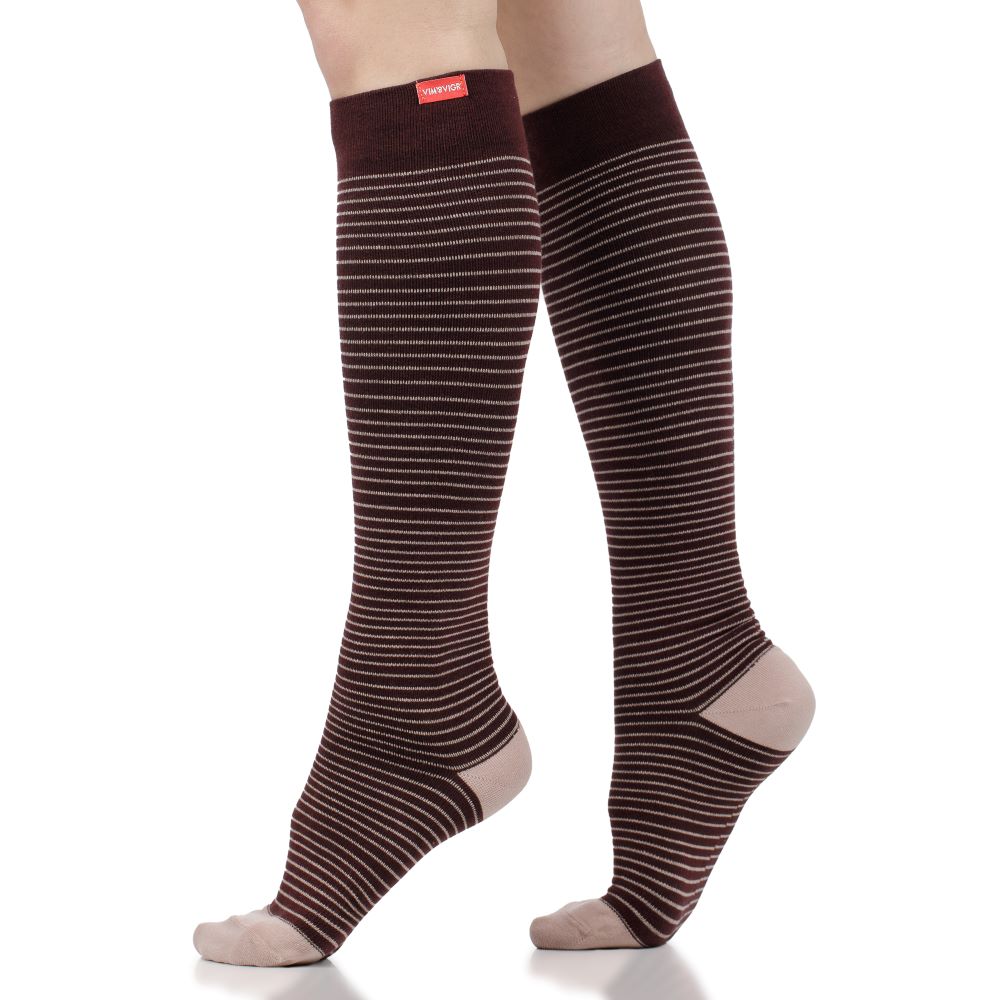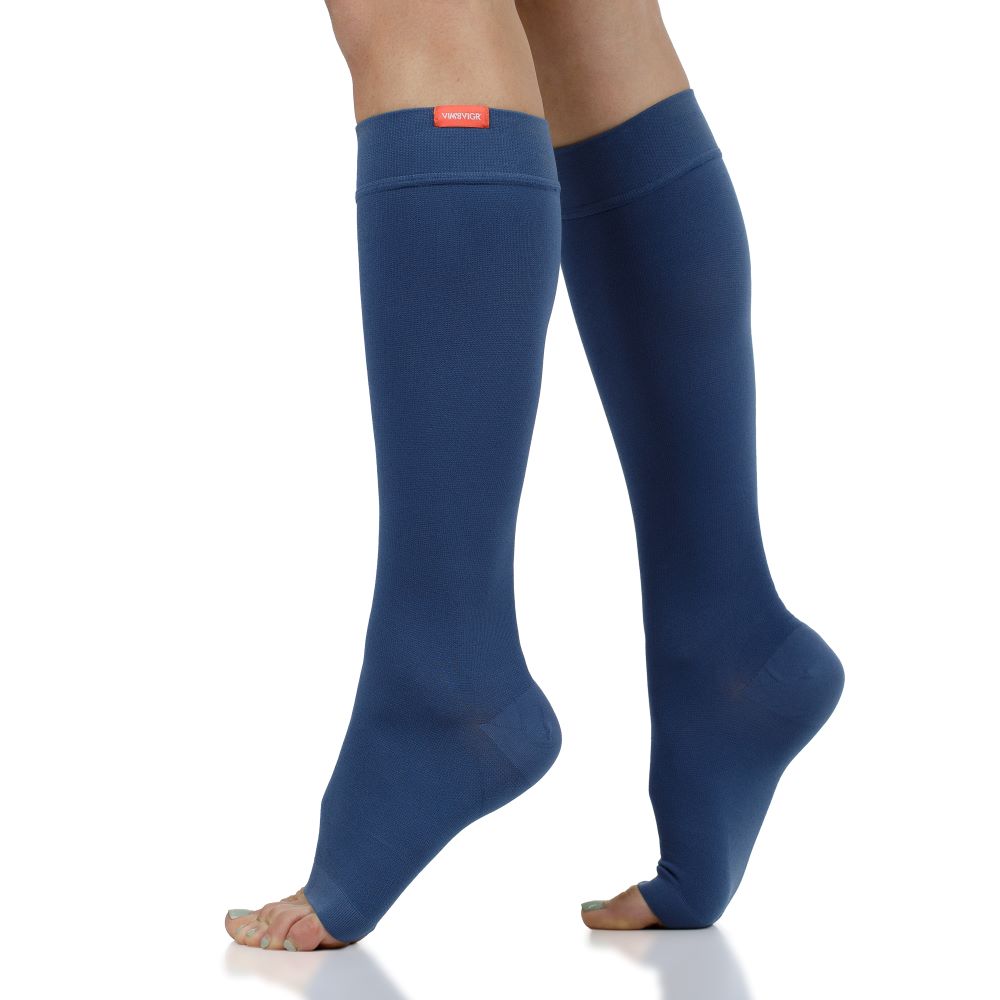EDS and Hypermobility: How Compression Clothing Can Help
Have you met anyone with hypermobile joints? It may seem like a cool quirk, but some people with hypermobile joints have significant health issues. According to the Hypermobile Syndromes Association, around 10% of hypermobile people suffer from syndromes that can range from mild to disabling. In fact, hypermobile EDS (Ehlers-Danlos Syndrome) is a notable health condition that affects approximately one in every 10,000 people. It can cause severe chronic pain and many negative side effects, but, thankfully, some of its symptoms can be alleviated by compression clothing according to a 2023 study.
How does compression clothing help with joint hypermobility caused by the Ehlers-Danlos syndrome? Thanks to the added support and massage action from compression garments, people with hypermobile EDS can get pain relief and benefit from joint stability to improve their quality of life.
Read on to understand more about Ehlers-Danlos Syndrome, the hypermobile variant and its symptoms, and how Ehlers-Danlos Syndrome compression clothing can help.
What is Ehlers-Danlos Syndrome (EDS)?
Ehlers-Danlos Syndrome appears as a cluster of syndromes that is typically due to genetics, but one report states that 50% of patients develop a mutation that was not inherited. EDS affects the skin, ligaments, blood vessels, internal organs, and bones.
Patients suffering from EDS could be affected by an extreme range of joint mobility - also known as the EDS hypermobility type. This means that their joints are very flexible, which can cause chronic pain.

Other types of Ehlers-Danlos syndromes can cause extremely stretchy skin (hyperelasticity), fragile skin which can bruise very easily, or fragile blood vessels that are easily damaged. In total, there are 13 EDS variants and the hypermobile variant is the most common.
The Symptoms of EDS and Hypermobility
So, how does hypermobile EDS affect people? People suffering from this EDS variant may have one or more of the following symptoms:
- Joint hypermobility
- Pain in the joints
- Clicking joints
- Loose joints that feel unstable and can dislocate easily
- Easily bruised skin
- Fragile blood vessels that can easily be damaged
- Extreme fatigue and low energy levels
- Problems with their internal organs that can include mitral valve problems or organ prolapse
- Getting dizzy and having an increase in heart rate after standing up
- Digestive issues, including suffering from heartburn or becoming constipated
- Bladder control problems
You may be wondering how hypermobility looks. We often meet people with very flexible joints or double joints. That is not what clinical hypermobility is. For joint hypermobility syndrome, this flexibility is also accompanied by pain and some of the elements on the list above. EDS symptoms may include fatigue or dizziness, and it will be more than a simple ability to overextend wrists or dislocate shoulders rapidly.
The Benefits of Compression Garments for Hypermobility and EDS
Compression clothing offers EDS hypermobility patients with joint and blood flow support, joint stability, and relief from chronic pain. According to studies like this one from 2022, individuals with hypermobility in their shoulders due to EDS had improved stability from wearing compression jackets. Another study from 2023 found that compression garments (like compression socks or leggings):
- Can reduce pain by around 25%
- Prevent recurring sprains in the ankles
- Prevent subluxation or luxation of the wrist, shoulder, knee, or hip
- Increase functional independence
Compression garments help hypermobility and EDS in the following ways:
- Gentle massage and pressure to the limbs, exerted by items like graduated compression socks, promote good blood flow and reduce the risk of swelling and pain from standing up or sitting still for long stretches.
- The added support from compression, especially around joints like the ankles, wrists, or shoulders can be beneficial in restricting hypermobility and movements that bring pain to those suffering from this condition.
- Compression can prevent dislocations of joints.
Through improvements in blood flow, compression garments may reduce inflammation and pain experienced by those with EDS.

Types of EDS Compression Clothing
Depending on the area affected by EDS hypermobility, there is a wide range of compression garments that can provide benefits.
For leg joint hypermobility, in the case of knees or hips, compression leggings feel great for most patients. They can be worn underneath regular garments to give that extra level of support and stability and pain relief while reducing swelling or inflammation. Another great option that you can wear with any outfit are compression stockings.

If you suffer from wrist or finger hypermobility, compression gloves can offer significant relief. They give the feeling of “holding the joints together” and allow patients to grab without dislocating their fingers.
Additionally, compression socks are ideal for those with hypermobile ankles. With a good pair of compression socks, however, you can hold your ankles and lower limbs tight, while also offering some relief from chronic pain. And it has all done while being completely subtle. Merino wool compression socks are a great choice because they give you the health benefits of compression while still being comfortable.
Aside from compression garments for hypermobility, you may also find the below items useful, depending on your doctor’s advice:
- A sacroiliac belt for hip stability;
- Crutches;
- Neck support collars;
- Kinesiology tape;
- Gels and creams against bruising and swelling;
- Braces;
- Heating pads and hot water bottles;
- Supportive shoes to increase stability.
- Wheel Chair
Tips for Choosing and Wearing EDS Compression Clothing
Your EDS compression garments need to be well-fitted and good quality to ensure you make the most of their potential benefits. Start with high-quality compression socks and slowly include more medically prescribed garments. Here are a few tips for choosing the right compression garment for EDS:
- Ensure you have the right size. Sizing is everything when it comes to compression. An item that does not fit tight enough does not provide support or stability, while wearing socks or leggings that are too tight will have negative effects on your blood circulation. It can also be quite painful and cause skin irritation. To ensure you buy clothing in the right sizes, always check sizing charts and take your measurements carefully.
- Get appropriate fabrics. When you are walking around in the heat of summer, you will want your skin to breathe and clothing to wick away sweat. However, cold weather will have you reaching for thicker, softer fabrics and for garments that are guaranteed to help your body retain heat. Knowing how the fabric you wear affects how you will feel is extremely important. Vim & Vigr compression socks are available in many fabrics like merino wool, nylon, and cotton so you can find the right fabric for your compression garments for EDS.
- Check reviews and testimonials. If you suffer from Ehlers-Danlos syndrome, you cannot afford to leave your clothing to chance. Ideally, you will discuss EDS compression clothing with your doctor to see if it suits your condition and to get some recommendations. Additionally, doing some research on forums and even reading product reviews online will help you understand which items are best suited for your EDS hypermobility.
- Do not go bland. Just because a piece of EDS compression clothing is functional, it does not mean it needs to be boring! Compression leggings come in lots of fun patterns and colors, while compression socks can literally brighten up your outfit and tone it up or down.
- Follow instructions to put on EDS compression clothing. Sometimes, tight items of clothing can be tricky to put on and remove, especially in the case of compression stockings and tights. Follow the manufacturers’ guides and tips on how to put them on correctly to make sure they fit right and that you don’t damage them in the process.
The Best Compression Socks for EDS
For patients suffering from EDS affecting their ankle and toe joints, compression socks are a great way to add support and stability. They will feel reassured throughout the day and can prevent or reduce chronic pain. Moreover, compression socks, tights and stockings better support your muscles and your blood flow, reducing swelling and discomfort.
Pick your compression socks depending on the pressure level you’re after (start with 15-20mmHg to get comfortable, but for advanced EDS hypermobility, you may want the highest level at 30-40 mmHg - you may need a prescription) and the activity you’re planning on (choose Merino wool for hiking and walking, thin Nylon stockings for a lightweight feel, or cotton for everyday wear).
Regardless of the EDS compression socks you choose, always ensure that they fit you well and that you care for them as advised. This will give you the best possible compression benefits, all while increasing the life of your favorite pairs of socks to keep fighting the symptoms of hypermobile EDS.
References
Hypermobility Syndromes Association. What is hypermobility? Read it here.
Miklovic, T., & Sieg, V.C. (2023). Ehlers-Danlos Syndrome. StatPearls [Internet]. Read it here.
Benistan, K., Pontier, B., Leblond, C., Flageul, O., Le Guicher, G., Enjalbert, M., & Gillas, F. (2023). The Effectiveness of Compression Garments for Reducing Pain in Non-Vascular Ehlers-Danlos Syndromes: A Prospective Observational Cohort Study. Healthcare (Basel, Switzerland), 11(13), 1862. Read it here.
Junkiert-Czarnecka, A., Pilarska-Deltow, M., Bąk, A., Heise, M., & Haus, O. (2019). New variants in COL5A1 gene among Polish patients with Ehlers-Danlos syndrome: analysis of nine cases. Advances in Dermatology and Allergology, 36(1), 29–33. Read it here.
National Health Service. (2022). Ehlers-Danlos syndromes. nhs.uk. Read it here.
Chaléat-Valayer, E., Denis, A., Zelmar, A., Pujol, A., Bernadou, A., Bard-Pondarré, R., & Touzet, S. (2022). VETCOSED study: efficacy of compressive garments for patients with hypermobile Ehlers-Danlos syndrome on shoulder stability and muscles strength. Disability and rehabilitation, 44(13), 3165–3172. Read it here.
Charles, T., Mackintosh, D., Healy, B., Perrin, K., Weatherall, M., & Beasley, R. (2011). Merino wool graduated compression stocking increases lower limb venous blood flow: a randomized controlled trial. Advances in therapy, 28(3), 227–237. Read it here.
Moñux, G., Serna-Soto, M., Plá-Sanchez, F., Zamorano-León, J. J., Segura, A., Rial, R., Freixer, G., Zekri-Nechar, K., Hugo-Martínez, C., Serrano, J., & López-Farré, A. (2021). Compression stockings attenuate the expression of proteins associated with vascular damage in human varicose veins. Journal of vascular surgery. Venous and lymphatic disorders, 9(2), 428–434. Read it here.


















Leave a comment